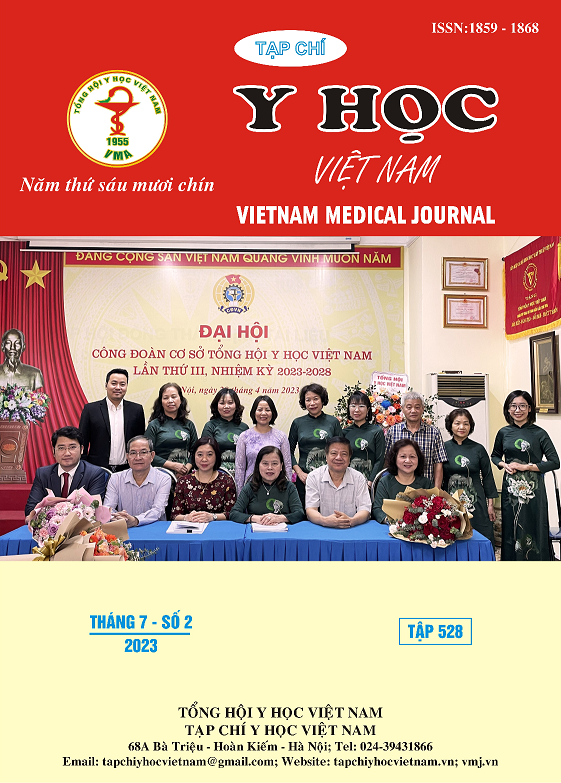THE ROLE OF MAGNETIC RESONANCE IMAGING IN DIFFERENTIAL DIAGNOSIS OF PYOGENIC ARTHRITIS AND TUBERCULOSIS ARTHRITIS
Main Article Content
Abstract
Purpose: To evaluate magnetic resonance imaging (MRI) features in distinguishing tuberculous arthritis from pyogenic arthritis. Material and methods: Descriptive study on MRI images of 18 patients, including 07 patients with tuberculous arthritis and 11 patients with pyogenic arthritis confirmed by synovial biopsy. Thickening and enhancement of the synovial membrane, synovial fluid, bone erosion, bone marrow edema, edema and the characteristics of the soft tissue periarticular abscess were analyzed to distinguish pyogenic arthritis and tuberculosis arthritis on magnetic resonance imaging. Results: The thickness of the synovial membrane for pyogenic arthritis group on MRI was 7.1±3.2 mm, in the tuberculous arthritis group was 8.9±6.7 mm, there was no statistically significant difference between the 2 groups (p= 0.53) on the synovial thickness. There were 6 patients with thickness grade 1, 2 patients with grade 2 and 3 patients with grade 3 in the group of pyogenic arthritis. In the tuberculosis arthritis group, there were 4 patients with grade 1, 2 patients with grade 2 and 1 patient with grade 4. Synovial fluid was found in 6/11 patients with pyogenic arthritis (account for 55%) but only 1/7 patients with tuberculosis (account for 14%). Bone erosion was the same common in patients with tuberculous arthritis (6/7 patients, account for 86%) as in those with pyogenic arthritis (9/11, account for 82%) (p = 0.84). Bone marrow edema was as common in pyogenic arthritis (10/11 patients, account for 91%) as in tuberculosis arthritis (6/7 patients, account for 86%) (p=0.78). Soft tissue edema occurs in 10/11 patients with pyogenic arthritis (account for 91%) but only 4/7 patients with tuberculosis arthritis (account for 57%). Soft tissue abscess was found in 6/11 patients with pyogenic arthritis (account for 64%) but for tuberculosis arthritis, only 3/7 patients (account for 43%). Conclusion: The characteristics of soft tissue edematous lesions and extraarticular abscesses provided useful information in differentiating tuberculous arthritis from pyogenic arthritis.
Article Details
Keywords
Magnetic resonance imaging, tuberculous arthritis, pyogenic arthritis, synovial membrane.
References
2. Forrester DM, Feske WI. Imaging of infec- tious arthritis. Semin Roentgenol 1996; 31:239 –249.
3. Smith JW, Piercy EA. Infectious arthritis. Clin Infect Dis 1995; 20:225–230.
4. Munk PL, Vellet AD, Hilborn MD, Crues JV III, Helms CA, Poon PY. Musculoskeletal infection: findings on magnetic reso- nance imaging. Can Assoc Radiol J 1994; 45:355–362.
5. Gylys-Morin VM. MR imaging of pediat- ric musculoskeletal inflammatory and in- fectious disorders. Magn Reson Imaging Clin N Am 1998; 6:537–559.
6. Kang HS, Yeon KM. Differentiation be- tween tuberculous and pyogenic spondy-litis: MR imaging characteristics of paraspi- nal mass. J Korean Radiol Soc 1996; 34: 825– 830.
7. Sitt J, Griffith JF, Lai FM, et al. Ultrasound-guided synovial Tru-cut biopsy: indications, technique, and outcome in 111 cases. European radiology. 2017;27(5):2002-2010.
8. Prakash M, Gupta P, Dhillon MS, Sen RK, Khandelwal N. Magnetic resonance imaging findings in tubercular arthritis of elbow. Clin Imaging 2016;40:114-8.
9. Choi JA, Koh SH, Hong SH, Koh YH, Choi JY, Kang HS. Rheumatoid arthritis and tuberculous arthritis: Differentiating MRI features. AJR Am J Roentgenol 2009 ;193 :1347-53.
10. Graif M, Schweitzer ME, Deely D, Matteucci T. The septic versus nonseptic inflamed joint: MRI characteristics. Skeletal radiology. 1999; 28 (11): 616-620.


